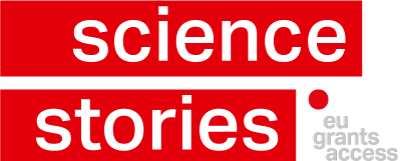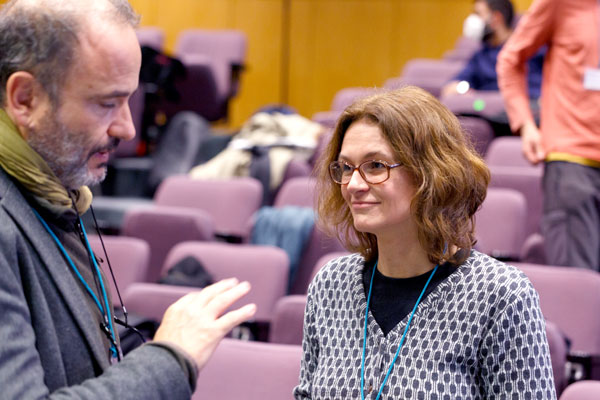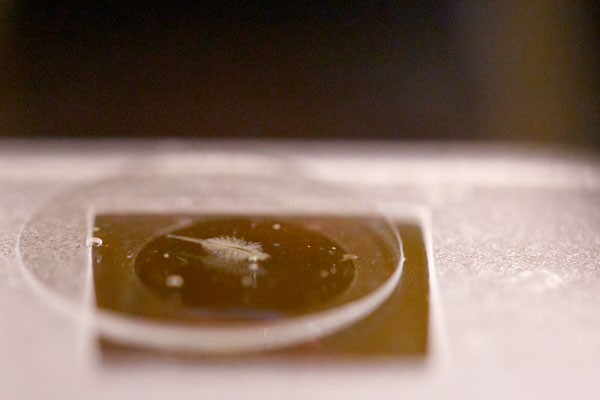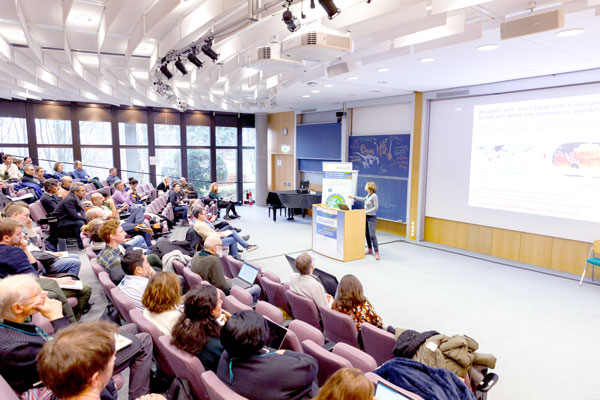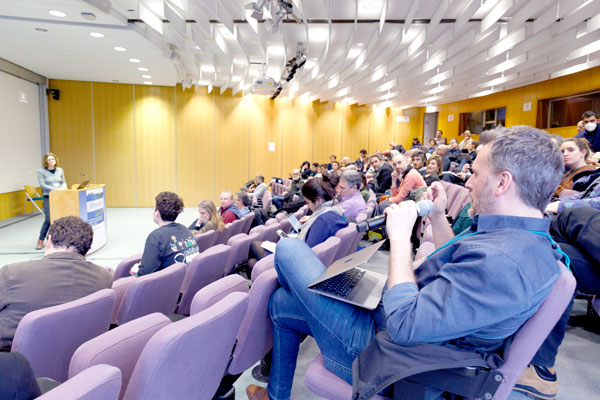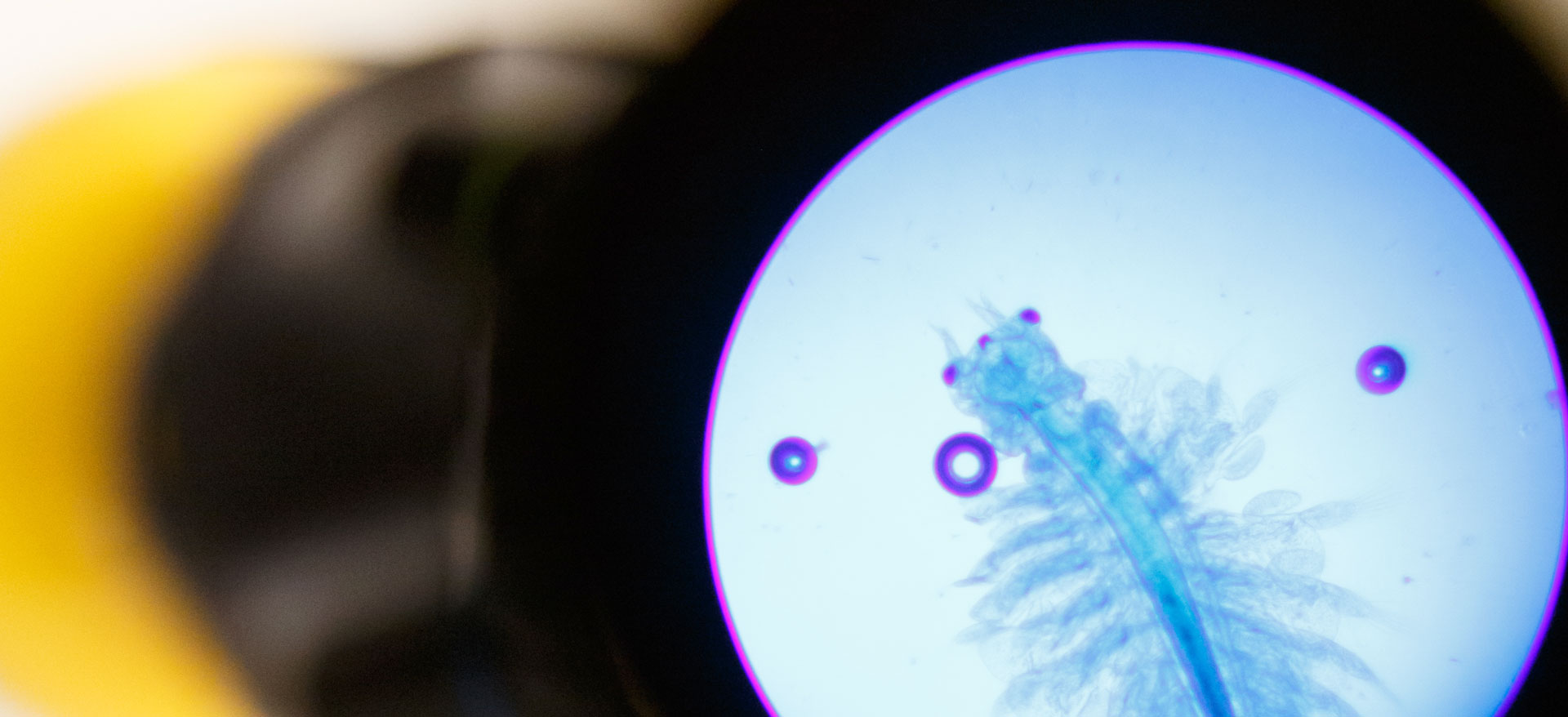
On the richness of life in the oceans
What fascinates her so much about plankton, how she gets her data and why she likes working in EU research projects. On the road with Meike Vogt, climate researcher and marine ecologist at ETH Zurich.
Early in the morning of 11 January 2023, Meike Vogt boards the train in Basel. Her destination: the European Molecular Biology Laboratory (EMBL) in Heidelberg. Over the next three days, 80 scientists from all over Europe will meet there for the kick-off of the EU-funded BIOcean5D research project. Behind the cryptic acronym is the ambitious endeavour to comprehensively understand, assess and predict marine biodiversity and the human impact on it. The project website of the European Commission states that «recent surveys of marine ecosystems have unveiled our ignorance of the richness and functioning of marine life, which is changing in the Anthropocene at a faster pace than terrestrial life.» This lack of knowledge prompted microbiome researcher Peer Bork from the EMBL Heidelberg and marine biologist Colomban de Vargas from the Station Biologique de Roscoff (SBR) in Brittany to initiate the BIOcean5D Project and submit a funding application to the European Commission. Through their networks, the two scientists have brought together researchers from the fields of marine biology, virology, cell biology, zoology, ecology and econometrics from eleven European countries to form a project group, which is meeting for the first time this 11 January in the conference hall of the EMBL Heidelberg. Meike Vogt is one of the 80 researchers who have travelled to the kick-off.
The fascination of plankton
Meike Vogt came to marine ecology in a roundabout way. She initially wanted to become an astronomer, studied Physics and graduated with a Master’s degree in Quantum Field Theory. When it came to doing her doctorate, she decided to switch to Biogeochemistry and become a climate modeller instead. She accomplished her PhD in Environmental Sciences at the University of East Anglia, discovering the fascinating world of plankton. «I was allowed to participate in a field experiment in Norway in the first year of my doctoral thesis. That’s when I saw plankton through the microscope for the first time and realised that the microscopic world is just as beautiful as the macroscopic world you observe through the telescope,» she describes her entry into the world of marine ecology. Since then, Meike Vogt has been involved in research into marine plankton and marine ecosystems. «Plankton have many aspects that interest me. For one thing, they are virtually the oldest creatures on our planet. Some of the species I work with have been here for over three billion years and nature has had all the time in the world to adapt them optimally to their environment. This has resulted in an enormous diversity of microscopic organisms. Secondly, plankton produces about half of the biomass of our planet. Plankton fixes as much carbon as all the trees, bushes and grasses of the entire terrestrial biosphere combined. And thirdly, as a biogeochemist, I am particularly interested in the function of plankton organisms. Plankton systems are involved in all the natural biogeochemical metabolic cycles of our planet, from carbon and nitrogen to sulphur or iron cycles.»
«Plankton fixes
as much carbon
as the plants of
the entire terrestrial
biosphere combined.»
With her research, Meike Vogt is looking for answers to fundamental questions such as: how many organisms of what type are there in the oceans and what functions do they have? Which contribute most to biogeochemical cycles? Which are relevant for the CO2 uptake of the oceans? The researcher’s main focus is on the interaction of the many different organisms in the plankton networks and the function of important plankton groups in marine ecosystems. Plankton ecosystems absorb CO2 from the sea surface in the following ways: phytoplankton species fix carbon via photosynthesis. Animal-like creatures absorb it when they eat phytoplankton and use it in the construction of their bodies and in their metabolic processes. Their excreta and, after their death, their carcasses sink into the depths. This creates a kind of biological pump that transports carbon from the sea surface to the seabed, where it is deposited in sediments.
The search for data
New approaches in biology such as systems thinking, combined with new measurement methods, technologies and procedures in imaging and metagenomics, have given marine research an enormous boost in recent decades. Many of the plankton species have only recently been discovered. A large part of the genetic matter cannot yet be described precisely or assigned to specific organisms and functions. Large amounts of data have been created and stored somewhere in the world in marine stations, laboratories or in researchers’ notes.
When Meike Vogt started her plankton research 18 years ago, she first had to take care of the data basis. «I am originally a climate modeller who wants to describe plankton biologically and functionally correctly in an ocean model. But I quickly realised during my doctoral thesis that the data basis for this was lacking. At that time, together with my dissertation advisor, I began to compile global data that had been collected worldwide over the years. They form the basis for finding out which plankton organisms exist in which concentrations in the oceans and which live together with which species and where.» Meike Vogt continued this data collection work after completing her dissertation and coordinated MAREDAT (MARine Ecosystem Biomass DATa), a worldwide network of researchers and institutions. Together with this team, she compiled, systematised and processed previous and current data from 500,000 marine measuring stations between 2009 and 2013 and published it in 2013 in the first atlas of marine plankton. «That was a tremendous work. MAREDAT is the scientific contribution of which I am most proud,» the researcher sums up.
«In a climate model,
it is technically impossible
for the computer
to take 300 Plankton
species into account.»
MAREDAT was intended to serve as a database to improve the climate models. However, it quickly became apparent that this data could also be used to understand the plankton systems much better. Meike Vogt began to use statistical methods and machine learning to derive patterns and correlations from the data, which in turn benefit the climate models. For instance, «There is a group of phytoplankton that form calcareous shells and thus bind CO2. After these organisms die, the shells sink into the depths. This is how the CO2 gets from the sea surface to the seabed. About 300 species of this phytoplankton exist. In a climate model, it is technically impossible for the computer to take 300 species into account. However, we have found that the 300 species can be divided into three main groups that live in different habitats and pursue different strategies in the ecosystem. Thus, we can now recommend to the climate modelling community to include these three types in their models and adequately represent diversity.»
It was clear to Meike Vogt and her team that collecting data was not finished with the first atlas for marine plankton. An EU project offered new opportunities. Seven years after the publication of MAREDAT, the AtlantECO project was launched in 2020 with the aim of understanding the role of microorganisms in Atlantic ecosystems and laying the foundations for sustainable management of the ocean. Researchers from twelve European countries as well as Brazil and South Africa are participating. Meike Vogt is prominently involved in this project. Thanks to AtlantECO, she can update and expand the MAREDAT data collection. «By autumn 2022, we could collect forty times as much data under AtlantECO as we did before with MAREDAT and I hope this continues.»
The magic of teamwork
By now it is 3 pm in the EMBL conference room in Heidelberg – time for Meike Vogt’s presentation. The research work in the BIOcean5D project is divided into seven thematic foci. One working group is responsible for each. Meike Vogt is co-leader of the team that has to obtain and process data on the entire diversity of life in the oceans – from viruses to plankton organisms to whales, and this over temporal and spatial scales from pre-industrial times to the present day. This wealth of information is to be accessible to all researchers via a data hub. In her presentation, Meike Vogt gives the plenary an overview of the goals, objectives and schedule of her working group and the need for coordination with the other teams. The detailed work planning and coordination within and between the teams then takes place on the following two days of the kick-off.
«New knowledge
is emerging at
such a pace
that it’s simply
no longer worth
brooding over
a topic alone.»
During the coffee break, we learn from Meike Vogt and Peer Bork, the co-lead of their working group and overall project leader of BIOcean5D, how complex it is to obtain and prepare the data. The data are available in a wide variety of forms and formats, depending on the subject. However, digital data sets of a gene sequencing cannot simply be combined with recordings of acoustic signals of marine mammals. To do this, the data must first be harmonised and digitally processed and ordered according to a uniform standard. Only then can they be analysed and meaningfully linked with each other so that correlations and patterns become visible. It is obvious that such work can only be done by a large international team of researchers and experts. This is entirely in Meike Vogt’s spirit. «I am a big fan of Open Science. New knowledge is emerging at such a pace today that it’s simply no longer worth brooding over a topic alone. For me, this democratisation of access to information is the only way to be able to process the mass of new information in a meaningful way. That’s why I like to be involved in cooperative EU projects like AtlantECO and BIOcean5D.»
EU projects play a key role in Meike Vogt’s scientific career. She has already worked on EU projects as a doctoral student and postdoctoral researcher. She is currently involved in three EU-funded research projects and contributes to others. What conclusions does she draw from her experience with EU projects? «They are enormously exciting, but administratively very time-consuming. A project application alone comprises several hundred pages. I am therefore glad that I have a partner in EU GrantsAccess who reliably supports me even with short deadlines. I wouldn’t be able to manage these administrative requirements on my own. But I wouldn’t want to miss these projects by no means. For me, they are a driver of new collaborations and encounters with people I would otherwise never meet.»
At the end of the day, I ask Meike Vogt what she wants for her future as a scientist. «One day, when I’m on a ship somewhere in the ocean, I want to throw a bucket overboard and look at the composition of the plankton. Then I want to be able to say: these and those species I see there are central to this ecosystem. If they can no longer fulfil their functions in their environment or if they migrate, for example because of climate change, this ecosystem will change drastically.»
Plankton
Plankton refers to the totality of organisms that float in the water and are driven by the current. Plankton comes in all life forms, from viruses and bacteria to plants (phytoplankton) and animals (zooplankton), and in all sizes, from microorganisms to metre-long jellyfish.
Interview with Meike Vogt (in German)
Meike Vogt
Meike Vogt studied Physics at Ludwig-Maximilians-Universität in Munich from 1998 to 2004 and completed her Master's degree at the Max Planck Institute for Physics in 2004. She then began her doctoral studies in Biogeochemistry at the Max Planck Institute in Jena, which she continued in 2005 at the University of East Anglia in Norwich and completed in 2008 with a dissertation on marine ecosystems and climate. After her doctorate, Meike Vogt joined ETH Zurich in 2008, where she took up a postdoctoral position in the Environmental Physics research group at the Department of Environmental Systems Science. She has been a Senior Researcher since 2010 and works on climate modelling and marine ecology. Meike Vogt lives with her partner and her daughter in the canton of Aargau.
Horizon Europe Projects
BIOcean5D: Marine Biodiversity Assessment and Prediction Across Spatial, Temporal and Human Scales
- Programme: Collaborativs project with 26 partners
- Duration: 1. December 2022 – 30. November 2026 (48 months)
- Contribution for ETH Zurich (financed by SBFI): 1’300’706 CHF
